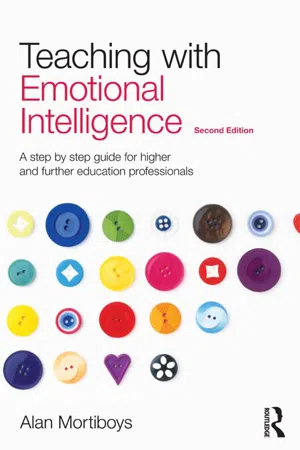
Teaching with Emotional Intelligence
A step-by-step guide for Higher and Further Education professionals
- 164 pages
- English
- ePUB (mobile friendly)
- Available on iOS & Android
Teaching with Emotional Intelligence
A step-by-step guide for Higher and Further Education professionals
About this book
The way teachers shape and handle their own feelings and those of their learners is central to the success of learning. Now in its second edition, Teaching with Emotional Intelligence shows how to manage this influential yet neglected area of learning and teaching. This practical book looks at how lecturers and teachers can develop and use their emotional intelligence to enhance their teaching and their students' learning.
Taking the reader step-by-step through the learning process and looking at the relationship from the perspective of both the teacher and the learner, this book will help the reader to:
- plan the emotional environment;
- learn how to relate and listen to learners effectively;
- read and respond to the feelings of individuals and groups;
- handle and reveal their feelings as a teacher, as appropriate;
- develop self-awareness as a teacher;
- recognise their prejudices and preferences;
- improve non-verbal communication;
- plan for the physical experience of learners;
- deal with their learners' expectations, comments and questions.
This book contains a number of revised activities, checklists and points for deeper reflection as well as new chapters on teaching with emotional intelligence with international students, in online learning and in working one-to-one with students. It will help all teaching professionals encourage their learners to become more engaged, creative, positive and motivated.
Frequently asked questions
- Essential is ideal for learners and professionals who enjoy exploring a wide range of subjects. Access the Essential Library with 800,000+ trusted titles and best-sellers across business, personal growth, and the humanities. Includes unlimited reading time and Standard Read Aloud voice.
- Complete: Perfect for advanced learners and researchers needing full, unrestricted access. Unlock 1.4M+ books across hundreds of subjects, including academic and specialized titles. The Complete Plan also includes advanced features like Premium Read Aloud and Research Assistant.
Please note we cannot support devices running on iOS 13 and Android 7 or earlier. Learn more about using the app.
Information
Chapter 1
The emotionally intelligent
teacher
Devel...
Table of contents
- Front Cover
- Teaching with Emotional Intelligence
- Dedication
- Title page
- Copyright
- Contents
- Acknowledgements
- Preface to the second edition
- Activities
- Introduction
- 1 The emotionally intelligent teacher
- 2 How you relate to your learners
- 3 Planning the emotional environment
- 4 Planning for the physical experience of learners
- 5 Dealing with your learners' expectations
- 6 Acknowledging individual learners
- 7 Listening to your learners
- 8 Reading and responding to the feelings of individuals and groups
- 9 Responding to learners' comments and questions
- 10 Developing self-awareness as a teacher
- 11 Recognizing your prejudices and preferences
- 12 Your non-verbal communication
- 13 Shaping and handling your feelings
- 14 Revealing your feelings to learners
- 15 Teaching with emotional intelligence one-to-one
- 16 Teaching with emotional intelligence with online learners
- 17 Teaching with emotional intelligence with international students
- 18 Continuing your development as an emotionally intelligent teacher
- Conclusion and further reading
- References
- Index